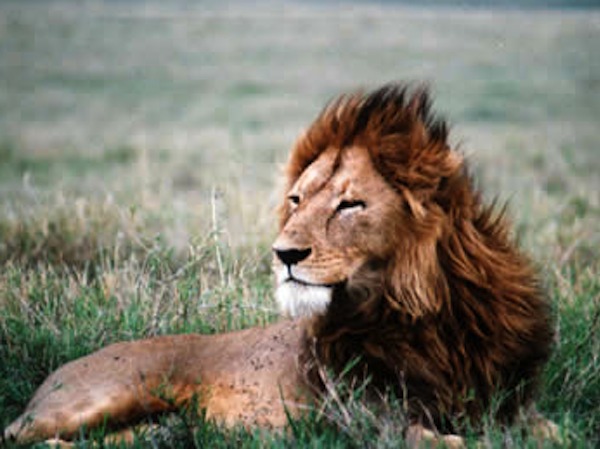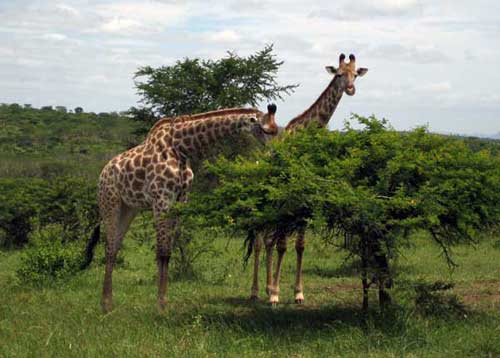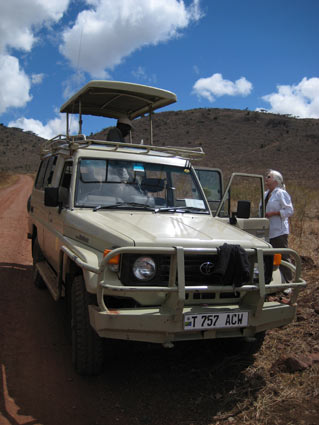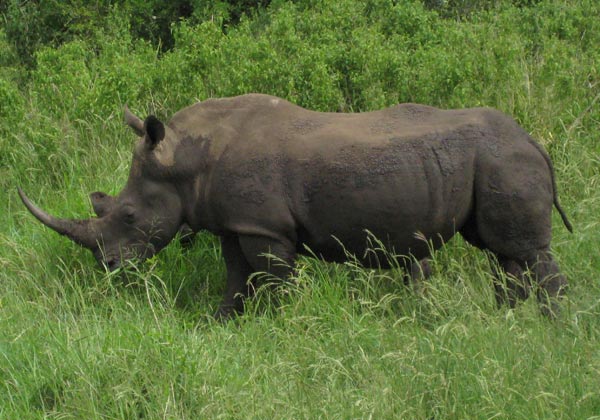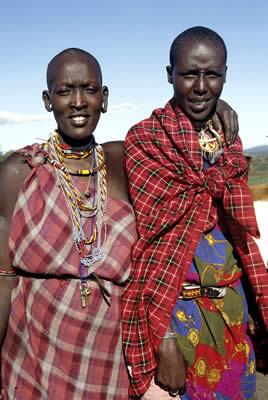Tanzania Safari Overview A majestic elephant greets safari participants. Antje Gunnar
Tanzania offers some of the best, if not the best, game-viewing in Africa. The places we visit have drawn travelers for over a century, including Lake Manyara National Park, where thousands of elephants roam in herds of up to three hundred; the Serengeti, host of the famous Great Migration; the Rift Valley, where some of the world's most gifted human runners have come from; and the Ngorongoro Conservation Area, where a crater 14 miles across and 2000 feet deep provides habitat for uncountable numbers of lions, wildebeest, zebra, buffalo, jackal, elephants, hippo, and many other exotic species. Lovers of adventure can combine a walking safari with a Kilimanjaro trek to experience some of the most distinctive landscapes, wildlife, and cultures in East Africa.
The world "safari" translates literally as "journey" in Swahili, Tanzania's national language. Join us for anywhere between 3 and 7 days. A safari makes the perfect complement to a Kilimanjaro climb , but can also be arranged as a stand-alone adventure.
Both walking and driving safaris are possible, with lodging options ranging from luxury game lodges to beautiful campsites. Safari itineraries can be customized, or you can choose one of the options listed on the "Safari Options and Prices" Tab, on this page.
Save
Save
Save
Tanzania Safari Tanzania's Protected Areas The Tanzanian government has dedicated over 26,100 square mile of land to 14 national parks, two of which are UNESCO World Heritage Sites (Serengeti National Park and Kilimanjaro National Park). There are also a number of other protected areas, including the Ngorongoro Conservation Area (over 3125 square miles, and a UNESCO World Heritage Site) and the Selous Game Reserve.
The places we visit on safari include:
Land Cruisers take us through the Ngorongoro Crater. Shawn Olson
Ngorongoro Conservation Area: The huge Ngorongoro Crater hosts a large, permanent concentration of wildlife - about 75,000 wild animals year round - and is a UNESCO World Heritage Site. The crater itself is 14 miles across and 2000 feet deep at its deepest point. It is the largest unbroken volcanic caldera (collapsed volcano) in the world. All the typical plains herbivores, including wildebeest, zebra, Grants and Thomson's gazelle, are well-represented. Cape buffalo, hartebeest, lions, elephant, spotted hyena, hippo, jackal (silver-backed and golden), are also abundant. Cheetah, leopards, and several cats are present but sometimes difficult to see. The Ngorongoro is one of the few places left in east Africa where one can still see the black rhino, a rare and extremely endangered species. Giraffes reside on the crater rim. The area is also occupied by people of the nomadic Maasai tribe.
Serengeti National Park:
Lake Manyara National Park:
Lionesses keeping watch over the African plains. Keith Gunnar
Tarangire National Park: The Tarangire (1005 square miles) hosts the greatest concentration of wildlife outside the Serengeti ecosystem. It is also the one place in Tanzania where dry-country antelope such as the stately fringe-eared oryx and peculiar long-necked gerenuk are regularly observed. Lions, migratory zebra, wildebeest, buffalo, impala, gazelle, hartebeest, and eland, and herds of elephants up to 300 are regularly viewed. Very good bird-watching can be had here as well.
Arusha National Park:
Save
Save
Save
Tanzania Safari Safari Options and Prices
Most of the safaris that we plan are customized, as different
parties may want to choose their exact number of days, where they
want to go, as well as how they want to overnight (in luxury lodges
or in tent camps). Whether you are planning on a safari as a pre-
or post-climb activity, please get in touch with us about about
designing your itinerary.All safaris include 3 meals a day, park
fees, lodging and camping fees, guide and cook fees, camping
equipment (camping safaris), and transportation.
We offer three main types of safaris:
Driving safari - overnight in luxury lodges.
Driving safari - overnight in exotic campsites.
Walking safari - overnight in exotic campsites.
Leopards can be seen in the Serengeti. Antje Gunnar
1. Driving Safari - Overnight in Luxury
Lodges:
2-5 participants: $420/person/day
6-9 participants: $390/person/day
10-12 participants:$360/person/day
2. Driving Safari - Overnight in Exotic
Camps:
2-5 participants: $300/person/day
6-9 participants: $280/person/day
10-12 participants:$250/person/day
3. Walking Safari - Overnight in Exotic
Camps: [email protected] .
Tanzania Safari Details Dates
There are two group dates available. They are as follows:
Aug 20-23, 2024 - $3025
Dec 31 - Jan 3, 2024 - $3025
For other optionsm please contact the AAI Office at 360-671-1505 (Toll Free: 1-800-424-2249) or email: [email protected] to arrange dates for this program.
Volunteer Opportunities for Physicians
If you are a physician and you are looking for a medical volunteering opportunity, you should check out the Foundation for African Medicine & Education. Dr. Frank Artress, M.D., is the founder and director, and works with physicians seeking short- and long-term volunteer opportunities in Tanzania. Please visit his website www.fameus.net or email him at [email protected]
Tanzania Safari Related Courses
Program Finder
By Location
United States - Alaska
United States - Washington
United States - California
United States - Nevada
United States - Colorado
United States - Utah
Canada - British Columbia
South America - Argentina
South America - Bolivia
South America - Ecuador
South America - Patagonia
South America - Peru
Europe - Alps and Caucasus
Asia - Nepal and Tibet
Asia - Laos, Thailand, & Vietnam
Asia - China
Asia - Japan
Africa - Tanzania
Pacific and Antarctica
By Program Type
Instructional Courses
Group Summit Climbs
Expeditions
Skills Expeditions
Private Guided Programs
Treks, Tours, & Backpacking
Corporate Outings & Services
Government & Military
By Activity
Rock Climbing
Ice Climbing
Alpine Climbing
High-Altitude Climbing
Trekking and Backpacking
Skiing & Snowboarding
Guide Training & Rescue
Avalanche Training
Departure Month
Difficulty Level
Beginner
Moderate
Intermediate
Advanced
Very Advanced
x
